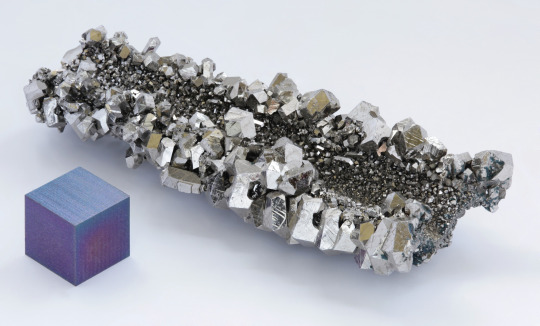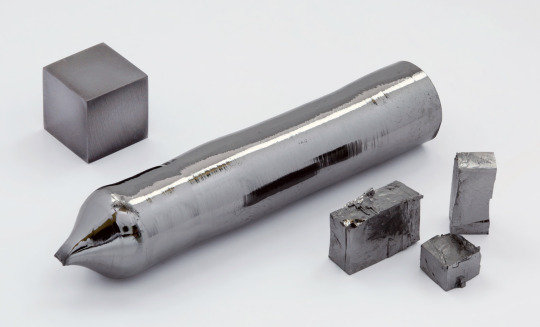#niobium
Explore tagged Tumblr posts
Note
may i request upscaled images of niobium and roentgenium to try and decipher their appearance a bit better
alrighty here

might change Roentgenium's design, particularly the head if i find something neat (and easier to draw xd) to replace the atom inside with, so maybe you should wait on that one
59 notes
·
View notes
Text

Ultrathin conductor surpasses copper for more energy-efficient nanoelectronics
As computer chips continue to get smaller and more complex, the ultrathin metallic wires that carry electrical signals within these chips have become a weak link. Standard metal wires get worse at conducting electricity as they get thinner, ultimately limiting the size, efficiency, and performance of nanoscale electronics. In a paper published in Science, Stanford researchers show that niobium phosphide can conduct electricity better than copper in films that are only a few atoms thick. Moreover, these films can be created and deposited at sufficiently low temperatures to be compatible with modern computer chip fabrication. Their work could help make future electronics more powerful and more energy efficient. "We are breaking a fundamental bottleneck of traditional materials like copper," said Asir Intisar Khan, who received his doctorate from Stanford and is now a visiting postdoctoral scholar and first author on the paper.
Read more.
#Materials Science#Science#Niobium#Phosphides#Thin films#Topology#Semimetals#Conductivity#Surfaces#Stanford University
36 notes
·
View notes
Note
I haven't seen anyone doing anodized niobium or niobium as a character before what do you think they might look like.

Here's both 'cuz I thought they would be different enought worth sketching.
They're able to bend solid metal, that includes gems that are metal (per example Bismuth). They're used for training Era 2 gems who struggle with their physical strength.
#niobium#ask#anon#gemsona#su#su future#sketch#steven universe#su gemsona#suf art#request#character design
50 notes
·
View notes
Text

Niobium is normally a gray metal, but it turns bluish when it oxidizes. When alloyed with other metals, it can create superalloys that can withstand extremely high temperatures.
14 notes
·
View notes
Text
Scientists in China have unearthed a never-before-seen type of ore that contains a rare earth element sought after for its superconductive properties. The ore, dubbed niobobaotite, is made of niobium, barium, titanium, iron and chloride, the South China Morning Post reported. It's the niobium that is causing excitement: This light-gray metal is currently used mostly in the production of steel, which it strengthens without adding significant weight. Niobium is also used in making other alloys (materials made of mixes of metals) and can be found in particle accelerators and other advanced scientific equipment because it is a superconductor at low temperatures, according to the Royal Society of Chemistry. The deposit was found in the Bayan Obo ore deposit in the city of Baotou in Inner Mongolia on Oct. 3. The brownish-black ore is the 17th new type found in the deposit and one of 150 new minerals found in the region, according to the China National Nuclear Corporation (CNNC).
Continue Reading.
133 notes
·
View notes
Text
Niobium/Nonbinary

Nonbinary- gender does not fall strictly within 100% ‘male’ or ‘female.’
Niobium was named after a Greek queen Niobe, who boasted about her twelve/fourteen children (depending on which version of the myth) making her superior to the goddess Leto who had two. The two children in question, Apollo and Artemis, killed all of Niobe’s children in retaliation. Fun times.
11 notes
·
View notes
Text
Niobium Pentachloride

Patreon
#studyblr#notes#chemistry#chemistry notes#chem#chem notes#mcat#mcat chemistry#compounds#chemical compounds#compound characteristics#niobium#chloride#niobium pentachloride#mcat studyblr#science#sciblr#scienceblr#laboratory science#lab science#laboratory sciences#chemical compound characteristics#compound properties#chemical compound properties#my notes#mcat study guide
3 notes
·
View notes
Text
Round 4 - Period 5, D-Block
#polls#periodic table#chemistry#yttrium#zirconium#niobium#molybdenum#technetium#ruthenium#rhodium#palladium#silver#cadmium
4 notes
·
View notes
Text





#oc#calcuflow#liverblue district#rutherfordium#dubnium#vanadium#niobium#silver#gold#zinc#manganese#silicon#aluminium
3 notes
·
View notes
Text
TRANSITION METALS: ROUND 2 POLL 1


NIOBIUM:
Used to make stainless steel, MRI scanners, and surgical implants
TANTALUM:
Hypoallergenic, meaning it doesn't irritate skin, even for people who are allergic to metal
7 notes
·
View notes
Text
That just makes me think of how different ATLA would be. Like you’re trying to fight the Sodium Nation and you’re a friggin Niobium bender

My latest cartoon for New Scientist
6K notes
·
View notes
Text
🎧 Golden Opportunities Podcast | Episode: St George Mining’s Critical Minerals Breakthrough
In this exciting episode of Golden Opportunities, we dive into St George Mining’s groundbreaking discovery in Brazil. ASX: SGQ has unveiled a maiden JORC resource with 41.2 million tonnes of niobium and 40.6 million tonnes of high-grade rare earths—a significant step toward shaping the future of critical minerals. 💎🌍
Join us as we explore:
Why niobium is a rising star in the critical minerals market 🌟
St George’s competitive edge with high-grade resources in a geopolitically strategic region 🗺️
How this discovery aligns with the global demand for critical minerals 🔋
This is more than a resource find; it’s a potential game-changer for investors and the mining world alike. 🚀
👉 Listen now to Golden Opportunities for the full breakdown
⚠️ This is not investment advice. Please do your own research before making investment decisions.
#StGeorgeMining#ASXSGQ#GoldenOpportunitiesPodcast#CriticalMinerals#Niobium#RareEarths#MiningInnovation#JORCResource#BrazilMining#GeopoliticalEdge#MiningDiscovery#ResourceExploration#CriticalSupplyChain#SustainableMining#GreenTechMetals#ElectricVehicles#CleanEnergy#MineralExploration#InvestorInsights#GeopoliticalRisks#NaturalResources
0 notes
Text

Niobium-tin magnet could be key to unlocking potential of heavy-ion accelerator
Researchers from Berkeley Lab's Accelerator Technology & Applied Physics (ATAP) Division have teamed up with colleagues from Michigan State University's Facility for Rare Isotope Beams (FRIB), the world's most powerful heavy-ion accelerator, to develop a new superconducting magnet based on niobium-tin (Nb3Sn) technology. This magnet, the first of its kind, could significantly improve FRIB's performance and enhance its capabilities, opening up new applications in medicine, industry, and research. The paper is published in the journal IEEE Transactions on Applied Superconductivity. At FRIB, beams of ionized atoms (ions) of elements spanning the periodic table, including heavy elements like uranium, are accelerated to half the speed of light. When these beams collide with a target, they break apart to create short-lived isotopes.
Read more.
24 notes
·
View notes
Text
𝗡𝗶𝗼𝗯𝗶𝘂𝗺 𝗠𝗮𝗿𝗸𝗲𝘁: 𝗔 𝗖𝗿𝗶𝘁𝗶𝗰𝗮𝗹 𝗠𝗲𝘁𝗮𝗹 𝗣𝗼𝘄𝗲𝗿𝗶𝗻𝗴 𝗧𝗼𝗺𝗼𝗿𝗿𝗼𝘄’𝘀 𝗜𝗻𝗱𝘂𝘀𝘁𝗿𝗶𝗲𝘀
The niobium market size is forecast to reach US$1.7 billion by 2027 after growing at a CAGR of 5.1% during 2022-2027.
𝐃𝐨𝐰𝐧𝐥𝐨𝐚𝐝 𝐑𝐞𝐩𝐨𝐫𝐭 𝐒𝐚𝐦𝐩𝐥𝐞: 👉 https://lnkd.in/eYnc2cUN
𝐊𝐞𝐲 𝐓𝐫𝐞𝐧𝐝𝐬:
🔹 𝗚𝗿𝗼𝘄𝗶𝗻𝗴 𝗗𝗲𝗺𝗮𝗻𝗱 𝗶𝗻 𝗛𝗶𝗴𝗵-𝗣𝗲𝗿𝗳𝗼𝗿𝗺𝗮𝗻𝗰𝗲 𝗦𝘁𝗲𝗲𝗹 𝗣𝗿𝗼𝗱𝘂𝗰𝘁𝗶𝗼��
Niobium’s ability to significantly enhance the strength, #toughness, and weldability of steel—especially high-strength, low-alloy (HSLA) varieties—is driving its #adoption across construction, automotive, and infrastructure projects.
🔹 𝗘𝘅𝗽𝗮𝗻𝘀𝗶𝗼𝗻 𝗶𝗻 𝗔𝗲𝗿𝗼𝘀𝗽𝗮𝗰𝗲 𝗮𝗻𝗱 𝗗𝗲𝗳𝗲𝗻𝘀𝗲 𝗔𝗽𝗽𝗹𝗶𝗰𝗮𝘁𝗶𝗼𝗻𝘀
The aerospace and defense sectors increasingly rely on niobium for its high melting point and #corrosion resistance. It is a critical component in superalloys used for jet engine parts, turbine blades, and other high-temperature, high-performance #applications.
🔹 𝗘𝗺𝗲𝗿𝗴𝗶𝗻𝗴 𝗥𝗼𝗹𝗲𝘀 𝗶𝗻 𝗘𝗻𝗲𝗿𝗴𝘆 𝗦𝘁𝗼𝗿𝗮𝗴𝗲 𝗮𝗻𝗱 𝗘𝗹𝗲𝗰𝘁𝗿𝗼𝗻𝗶𝗰𝘀
Innovations in battery #technology—such as the development of battery-grade niobium oxide—are opening new markets in energy storage and advanced electronics. Niobium’s properties improve the performance and durability of components in lithium-ion batteries, superconducting magnets, and optical devices, which are critical for #electric vehicles and renewable energy systems.
𝐆𝐞𝐭 𝐦𝐨𝐫𝐞 𝐢𝐧𝐟𝐨: https://lnkd.in/efWnnfzM
𝐊𝐞𝐲 𝐏𝐥𝐚𝐲𝐞𝐫𝐬: • ATI • Nucor Corporation • United States Steel Corporation
• ArcelorMittal USA • Commercial • Steel Dynamics, Inc • Worthington Industries • Carpenter Technology Corporation • TimkenSteel Corporation
• Arconic • Alcoa • Reliance Steel Industries (RSI) GKN plc • LIBERTY Steel Group • Tata Steel • Johnson Matthey • Meggitt • Renishaw • Tata Steel UK
✨ (𝐂𝐫𝐞𝐝𝐢𝐭 𝐂𝐚𝐫𝐝 𝐃𝐢𝐬𝐜𝐨𝐮𝐧𝐭 𝐨𝐟 𝟏𝟎𝟎𝟎$ 𝐨𝐧 𝐚𝐥𝐥 𝐑𝐞𝐩𝐨𝐫𝐭 𝐏𝐮𝐫𝐜𝐡𝐚𝐬𝐞𝐬 | 𝐔𝐬𝐞 𝐂𝐨𝐝𝐞: 𝐅𝐋𝐀𝐓𝟏𝟎𝟎𝟎 𝐚𝐭 𝐜𝐡𝐞𝐜𝐤𝐨𝐮𝐭) https://lnkd.in/e24EV8b2

#Niobium#CriticalMetals#MarketTrends#InvestmentOpportunities#Aerospace#Automotive#SteelIndustry#RenewableEnergy
0 notes
Text
The Secrets of Rare Metals: What Makes Them Special?
Rare metals such as niobium, tantalum, and titanium might not be household names, but their unique properties make them indispensable in various industries. These metals possess extraordinary characteristics that set them apart, making them key players in advancing technology, medicine, and engineering. Let’s explore what makes these metals so special and why they hold a pivotal role in our modern world.

Niobium: The Strength Beneath the Surface
Niobium is often associated with its remarkable ability to enhance the strength and flexibility of steel. When added to steel, even in small amounts, niobium creates an alloy that is both lightweight and incredibly strong. This makes it a preferred choice for constructing bridges, skyscrapers, and pipelines that need to withstand extreme conditions.
Beyond construction, niobium’s superconducting properties have made it a cornerstone in medical and scientific advancements. Niobium-based superconductors (niobium capillary tube for example) are used in MRI machines, particle accelerators, and even in prototypes for quantum computing. These applications highlight its potential in revolutionizing both healthcare and cutting-edge research.
Tantalum: The Silent Performer in Electronics
Tantalum is a metal of extraordinary durability and conductivity. Its resistance to corrosion and high melting point make it ideal for use in the electronics industry, particularly in the production of capacitors and microchips. These tiny components are critical for the functioning of smartphones, laptops, and other electronic devices.
Additionally, tantalum’s biocompatibility has opened doors in the medical field. It is commonly used in surgical implants, such as bone replacements and dental devices, where its ability to integrate seamlessly with human tissue is invaluable. This dual role in technology and medicine underscores tantalum’s unique versatility.
Titanium: The Lightweight Powerhouse
Among the rare metals, titanium stands out for its exceptional strength-to-weight ratio and corrosion resistance. These properties make it a favorite in aerospace and marine industries. From aircraft frames to deep-sea submarines, titanium enables engineers to push the boundaries of innovation.
In healthcare, titanium has earned its reputation as a “wonder metal.” It is widely used in prosthetics, implants, and surgical instruments due to its biocompatibility and durability. Its hypoallergenic nature also makes it a safe choice for medical applications, ensuring reliability and longevity.
Why Are These Metals Considered “Rare”?
Despite their name, niobium, tantalum, and titanium are not exceedingly scarce in nature. However, their extraction and refinement are complex and resource-intensive processes, often requiring specialized techniques to ensure purity and usability. This rarity in processing capability, rather than abundance, is what gives them their “rare” designation.
The Environmental and Ethical Challenges
The mining and processing of rare metals come with significant environmental and ethical considerations. For instance, tantalum’s extraction has been linked to conflict zones, raising concerns about sustainability and responsible sourcing. Efforts to recycle these metals and develop more eco-friendly mining practices are gaining momentum, ensuring a balance between technological advancement and environmental stewardship.
The Future of Rare Metals
As technology evolves, the demand for niobium, tantalum, and titanium is expected to grow. Their unique properties make them crucial for emerging fields such as renewable energy, space exploration, and advanced medical treatments. From wind turbines to Mars rovers, these metals are shaping the future of innovation.
Conclusion
Niobium, tantalum, and titanium are far more than just elements on the periodic table. Their exceptional properties have a profound impact on industries that touch our daily lives and drive scientific discovery. Understanding their secrets not only highlights their value but also underscores the need for sustainable practices to harness their potential responsibly. Rare metals may be hidden in the background, but their influence on the modern world is anything but ordinary.
1 note
·
View note